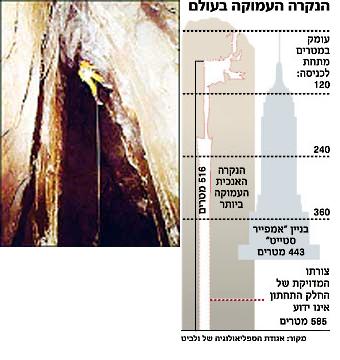The thorn that was discovered in Croatia. 66 meters deeper than the hole that held the previous world record
Mark Glassman New York Times, Haaretz, Walla

A vertical well in Croatia, which is 516 meters deep
Direct link to this page: https://www.hayadan.org.il/nikracroatia.html
Earlier this month, as thousands of Olympic athletes trained to compete in the Athens Games, a small team of Croatian speleologists set a new record that went largely unnoticed. They found the deepest hole in the world.
No medal ceremony awaited Draco Baksic, the head of the delegation, or any of his dust-covered colleagues when they reached the bottom of the 516-meter-deep pit. Just a long climb back up.
The pit - in the back of a dark cave in the Velabit mountains southwest of Zagreb - is approximately 66 meters deeper than the pit that held the previous record, located in Austria and known as "Hollenhall".
Sophisticated mapping methods left very little room for chance in the study of the Earth's surface. But the maps do not indicate what lies underground or under the ocean floor. "I'm not at all surprised that we're still making these kinds of discoveries," said Lisa Gaddis, project manager for the US Geological Survey's astrogeology team. In her opinion, "we have a better global picture of some planets, such as Mars, than the picture of the more remote areas of the Earth".
When it comes to caves, noted David Smith, head of NASA's Terrestrial Physics Laboratory, "we can't see anything from outer space." He added that "it is not possible to say much, if anything, about what lies beneath me
the surface".
The new find is not the deepest cave known to science on Earth. This title still belongs to the Kobra cave in Abkhazia, which descends to a depth of 1,564 meters, although without a sharp drop like that of the new discovery. Cave explorers define a hole, or pit, as a straight vertical cavity whose walls sometimes protrude from rock faces but is too steep to allow walking down into it.
"Until the period of modern speleology (cave research), pits often prevented entry into caves," so says the Atlas of the World's Largest Caves. Today, the research in most pits is carried out when the researchers hang by a rope to the bottom.
Baksic's team, which is now preparing accurate maps based on its field notes for publication of the findings, discovered the hole while exploring another cave nearby. "People usually don't go out looking for things like this," said Smith, "they tend to find them more or less by accident, during research."
The Underground World remains the last book of explorers searching for new discoveries. "It takes a special kind of person, who is willing to walk or crawl for a mile in complete darkness," added Smith.
Cave explorers are among the last amateur explorers. "For me it's like a profession," said Andrey Stroi, a member of the team that discovered the nekra in Croatia, "but for others it's mostly a hobby." Jim Chester, a member of the Explorers Club of New York, received the National Speleological Society's most prestigious caving award for his work mapping caves in Montana. But the exploration of the caves does not support him. "Everything I do with caves is for the weekends or vacations," said Chester, 60. During the week, he works as a mailman.
Bob Golden, an engineer from Maryland, updates the Speleology Society's list of the world's deepest pits. Golden is a member of a local caving club known as the Gangsta Mappers – a network of underground cartographers who remap caves that have already been explored, but with greater care and detail. "In every cave they remap," Golden said, "they always find another passage."
Cave explorers do not have the technology that scientists such as Smith or Gaddis enjoy. "You have to do it in your own body," said Golden. A ground-penetrating radar could detect the existence of an underground space, he said, but this type of equipment is too expensive and impractical for ordinary cave explorers.
Researchers use old tricks to find new caves, such as looking for depressions in the snow or following the spread of water currents in the mountains. Chester said his group often goes on aerial tours in the winter to look for "smoky vents" — pockets of steam emanating from the snow that can indicate the presence of warm air rising through a cave system. "We don't know what the deepest cave in the world is," Chester said, "and unless there is some major breakthrough, such as a CT scan of the Earth, we may never know."
https://www.hayadan.org.il/BuildaGate4/general2/data_card.php?Cat=~~~930689383~~~138&SiteName=hayadan
